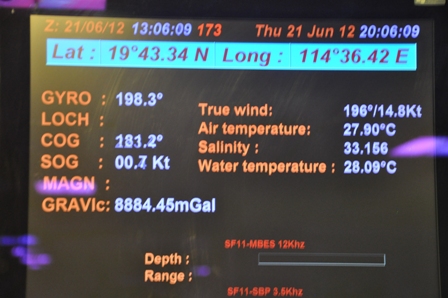In the next two weeks, GeoLog has the pleasure to host reports from Teachers at Sea. This educational programme, co-sponsored by the European Geosciences Union (EGU) and the French Polar Insitute (IPEV), gives school teachers the opportunity to take part in oceanographic cruises with scientists. This year, Sandrine Vivier and Ana Sánchez, teachers of Biology and Geology in Rodez (France) and Madrid (Spain), respectively, together with EGU’s Education Chair Carlo Laj, join scientists on board of the Marion Dufresne. The research vessel is navigating the South China Sea where teachers will work alongside scientists in collecting marine sediments to retrieve the secrets of deep ocean circulation and understand past variations of the Asian Monsoon.
Report 4: The first coring site!
Our adventure continued as the ship arrived to the first coring site on Wednesday evening. From now on, we are divided into three watches (sometimes called shifts). The three groups work 8 hours a daily, divided into two periods of 4 hours each.Operations began with a hydrological experiment: a rosette holding 24 opened bottles and a CTD (Conductivity, Temperature, Depth) sensor was lowered down into the sea, almost reaching the bottom at 660 meters. Then it was pulled up and at chosen depths, the bottles were successively closed by a command from the boat. In this way, each bottle recovers a sample of the water at the depth at which it was closed. In the end, we recovered 24 bottles (12 litres) each sampled at a specific depth and temperature, and a CTD profile. Once on board, our colleagues from the University Sains Malaysia in Penang, immediately froze and/or analysed these water samples to test in particular for their pH.After this experiment was completed, the team on the vessel attempted to core sediments with the Casq corer for the first time. This is a very large 25x25cm gravity square corer, 12 metres long. It has the capacity to recover a large amount of undeformed sediment.
Unfortunately, on this first attempt, the Casq was empty when it was pulled back on the deck! The system that traps the sediments in the corer as it is pulled up and back on to the ship did not work properly and the sediment was lost.
On the other hand, everything worked perfectly for the Calypso piston coring that the team performed immediately after: the corer recovered 28 metres of sediment with a core diameter of 10cm! Not bad at all! Microscope observation of a small amount of sediment from the core catcher points to an assembly of several fossil foraminifera (a type of marine plankton), which gives scientists an idea about the ‘age’ of the sedimentary sequence reached by the corer.
The second Casq coring was also successful, with the team recovering over 7 metres of undeformed sediments. And because Casq recovered such a large amount of sediment, the scientists on board could sample part of it for the teachers. Yes, you teachers will have ‘real’ marine sediments to show to your pupils!
As for the Calypso samples, it’s hard to imagine how we could bring a 28-metre core back to the laboratory in one piece… Naturally, the team cut the Calypso core into 1.5-metre segments (called sections), each carefully labelled so that its order is known with no possible error. These segments will be split afterwards longitudinally into two halves, one labelled working (W) and the other archive (A). Scientists do preliminary work on board on the W halves (description to come!) before both halves are sent to the laboratories.
The cutting, labelling, and storing of the samples went on all night long and continued in the morning. Everyone was rather exhausted at the end but excited about the job in hand. It all starts again tonight as we reach our next coring site!
If you have any questions for us, please leave them in the comments section of this post.
By Sandrine Vivier, Ana Sánchez, and Carlo Laj





concrete core drilling Brisbane
A coring drill bit is designed with a central opening, around which the drill bit cuts the borehole. The core samples enter this hole, into a special chamber – a coring barrel, as the coring bit advances and then the sample is returned to the ship by wire.